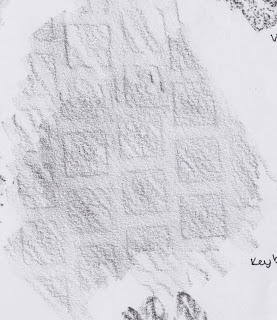Frottage
This surrealist technique was another developed by Max Ersnt shown in drawings from 1925. The term frontage is the french word for 'rubbing'. In 1925, Ernst began using the technique of frottage, which involves laying a sheet of paper over a textured surface and rubbing it with charcoal or graphite (the same process can be used to create a rubbing of a coin or an engraved surface). Ernst would typically use textured surfaces as passages in a larger composition. He also employed a sister technique, called grattage, in which an object is placed under a piece of paper, which is then covered with a thin layer of pigment. By scraping away the pigment one reveals a colorful imprint of the object and its texture. The painting Snow Flowers (1929) was created using both frottage and grattage.
 |
| Figure 1 - Snow Flowers, Max Ersnt 1929 |
Ernst was inspired by an accident wooden floor where the grain of the planks have been accentuated by years of scrubbing. He then captured this through layering sheets of paper on the floor and rubbing over with a soft pencil to capture the texture. The results from these rubbing suggested mysterious forests that were populated with bird like creatures. Ernst published a collection of the drawings in 1926 titles 'Histoire Naturelle' - Natural History.
 |
| Figure 4 - My frottage collection from in and around the studio |
Looking at the frontage of a key board and my recent interest in food illustration I decided to develop an idea waffles on a plate with a table cloth background.
 |
| Figure 5 - Frottage of a keyboard |
 |
| Figure 6 - Frottage of a step |
I put all of my chosen textures into Photoshop combining them with other preexisting textures I already had an created the image of waffles on a plate with cutlerly on a table cloth. The textures now can be manipulated on photoshop so I admire Max Ernst for having to traditionally construct his ideas.
 |
| Figure 7 - Finished frottage image |
Image references
Figure 1 -Ernst, M. and Society, A.R. (2016) Max Ernst | Fleurs de neige (snow flowers) (1929)
Figure 2 -Max Ernst. L’évadé (the fugitive) from Histoire Naturelle (natural history). 1926
Figure 3 - Corporation, A.W. (1972) Histoire naturelle by MaxErnst.
Bibliography
- Backus, J. (2014) Beyond painting: The experimental techniques of Max Ernst. Available at: https://www.artsy.net/article/jessica-beyond-painting-the-experimental-techniques-of-max (Accessed: 5 December 2016).
- Corporation, A.W. (1972) Histoire naturelle by MaxErnst. Available at: http://www.artnet.com/artists/max-ernst/histoire-naturelle-XEvkc4iTLxfhpbjGP_HByw2 (Accessed: 5 December 2016).
- Ernst, M. and Society, A.R. (2016) Max Ernst | Fleurs de neige (snow flowers) (1929). Available at: https://www.artsy.net/artwork/max-ernst-fleurs-de-neige-snow-flowers (Accessed: 5 December 2016).
- Max Ernst. L’évadé (the fugitive) from Histoire Naturelle (natural history). 1926 (no date) Available at: https://www.moma.org/learn/moma_learning/max-ernst-levade (Accessed: 5 December 2016).


No comments:
Post a Comment